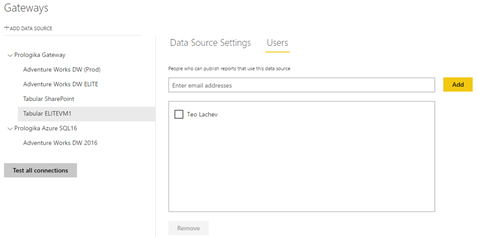Granting Publishing Rights to Power BI Enterprise Gateway
As I explained in a previous blog, the Power BI Enterprise Gateway allows Power BI reports to connect to on-premise data source. A gateway can support multiple data sources. When setting up a data source, you’ll see the Users tab on the data source properties. The users you add here will have rights to publish reports that can connect to a data source serviced by the gateway. This is another security check that Microsoft implemented to limit the number of people who can expose data via the gateway.
If a user is not in the Users tab, the user can publish a Power BI Desktop file to My Workspace (or to another Power BI workspace if it has rights) but the user won’t be able to view reports that connect to a gateway data source. When the user attempts to do so, Power BI will show an error that it can’t connect to the gateway but unfortunately it won’t tell you why. Another gotcha is that even though you might be an admin on the gateway, you won’t be able to view reports you publish unless you are added to the Users tab. I think Power BI just adds the original gateway admin but it doesn’t add users that are subsequently added as gateway administrators.
So, if you face obscure gateway connectivity errors, check the Users tab. In the screenshot below, only I have rights to publish reports that will connect to the gateway.
Question: How do I specify which gateway to use when I create a Power BI Desktop model.
Answer: You never specify a gateway that the report will use. You connect to the data source as you normally would, e.g. you specify the SSAS instance name as you would when connecting to it in Excel. Once you publish the Power BI Desktop file to powerbi.com and a user views the report, Power BI figures which gateway to use. So, gateways are transparent to both report author and viewer. This is good because gateways can be removed or multiple gateways can service the same data source to make it highly available.





